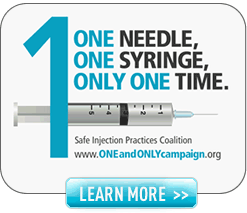
Steve Langan, director of HONOReform
Drug diversion, “anytime prescription drugs are obtained or used illegally,” is like climate change, in a way. In our experience, most people either do not want to believe it exists or cannot believe it exists. When you start to tell them about it, they close their ears. It’s not that they are rude or there’s a short attention span. It’s just too frightening—unexpected and baffling—too much for them to take in.
We are not in the business of creating wariness, mistrust or fear. We are simply in the business of safeguarding the medical injection process. One of the ways that drugs are diverted in healthcare systems or clinics is through improper injections.
Oftentimes—at least three times that we are aware of, three outbreaks in which multiple patients were infected with hepatitis C—an addicted, infected healthcare worker will inject medication prescribed to a patient into himself or herself, refill these vials with saline then put them reuse them.
If there’s even a speck of infected blood in that injection device, the patient who receives this injection could become infected. Also, the patient is not receiving the proper dose of prescribed medication.
When it comes to drug diversion, there are many overlapping patient safety and worker safety issues. Drug diversion has to be prevented. And, to prevent the problem, to really mobilize to prevent this problem, we need a clear, consistent and acknowledged definition of the problem.
Once again, it’s CDC to the rescue!
Just Google “CDC Drug Diversion,” and the ongoing problem is made clear. On the CDC page titled “Risks of Healthcare Associated Infections from Drug Diversion,” there are sections titled “Outbreaks,” “Prevention Resources,” “Enforcement Agencies,” and much more.
We have touted this work before, this extraordinary ongoing science and research collection, but it bears repeating, especially as we are working toward gathering for a national meeting on drug diversion prevention in early 2016.
The problem is clear, just a click away. We encourage all affected agencies and organizations to forge past the denial that often develops around this subject and work together to develop a plan and take action.



